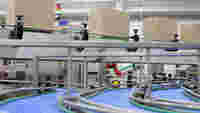Greater accuracy, speed and flexibility: Manufacturers of high-value and safety-related products place stringent requirements on their X-ray inspection systems. Nordson MatriX meets these by employing a modular concept that extends from the mechanical system up to the control software. MatriX systems are used during quality control of electronic components, medical implants and cast components. The roster of customers ranges from well-known firms in the automotive and medical industries to famous names in the consumer electronics industry.
This manufacturer, headquartered in Feldkirchen, Germany, and with a staff of nearly 100 employees worldwide, has produced automated machines since 1998. WAGO technology has played a role from the beginning. Initially, the engineers were simply interested in an I/O system that could be connected via ETHERNET. They hit pay dirt with WAGO. Then, shortly afterwards, the team decided that they needed a completely new fieldbus controller. At first, the controllers were only used as remote I/Os, without a PLC program. However, the developers were already aware that they would not be able to meet future real-time requirements on control tasks using a PC application and a TCP/IP-based remote I/O. Therefore, controller functionality became increasingly important in the following years. Each new generation of WAGO Controller brought the performance increase necessary for further development of the machines. At the time, MatriX was still named Macrotron Process Technologies and already considered the automation of its X-ray systems one of its core competencies. Under the name MatriX Technologies, the company really took off in 2004 and demonstrated compelling growth rates. MatriX has been a part of the Nordson Group since 2015.
The company’s automation experts are in high demand. Programming controllers, generating circuit diagrams, providing integrated automation that keeps pace with the ever-increasing miniaturization of electronics and addressing other customer needs – their work ensures the company’s competitiveness. Purchasers naturally expect that the machines will support extremely short cycle times to ensure quality and will operate at a high resolution. They also want to receive the Automated Inline X-ray Inspection systems (AXI), as well as the other MatriX equipment for non-destructive testing, shortly after ordering it.


